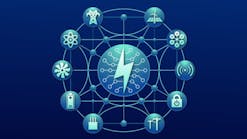How Distributed Intelligence Can Address the Electric Vehicle Charging Challenge
In the U.S., electric vehicle (EV) consumption surged 52% in the first two months of 2024 compared to the same period in 2023. With U.S. EV sales projected to exceed 4.6 million units by 2030, the electric future of transportation is upon us, but concerns about grid reliability are rising. This rapid growth threatens to strain the aging grid, especially as more than 70% of transmission lines are over 25 years old. Utilities are tasked with ensuring the grid can accommodate the energy demand of charging millions of vehicles; however, traditional approaches, such expanding grid infrastructure, are by themselves, no longer sufficient. Real-time data collection, distributed intelligence (DI) at the grid edge and advanced grid analytics and forecasting are key to managing the influx of EV chargers.
Identifying the Challenges of EV Charging Patterns
Unlike traditional household appliances, EV charging patterns are variable and depend on many factors, including driver habits, charging station availability and battery capacity. While most EV owners charge overnight at home, others rely on public chargers during the day. Charging frequency and duration can also significantly differ based on the EV type, driver habits and the battery state of charge. While driver habits vary, peak-hour charging is common, potentially overloading transformers and leading to power outages. The variability makes it extremely difficult for utilities to accurately forecast energy demand and allocate resources to prevent grid overloads.
The rise of EV vehicle fleets, such as public transportation buses and delivery trucks, adds another layer of complexity. These larger vehicles require bigger batteries demanding more facility power, placing a significant strain on the grid, especially when a fleet of large EVs charges simultaneously at central depots. The concentrated demand can lead to challenges with hosting capacity, grid instability and potential power outages, posing a substantial challenge for utilities tasked with maintaining a stable power supply.
Moving Beyond Traditional Solutions: The Power of Distributed Intelligence
To effectively manage the growing demand for EV charging, utilities must embrace modern, analytics-driven approaches. DI and advanced grid analytics offer the tools necessary to navigate the complexities of this new energy landscape.
DI offers real-time insight into EV charging patterns and control out to the grid edge, allowing for more precise energy management. It leverages high-resolution data capture, edge computing and peer-to-peer communication capabilities to provide real-time usage insights. This visibility is crucial for managing the variability of EV owner habits, as it provides both utilities and consumers information on their energy consumption. DI technology also facilitates dynamic adjustment of power flows, balancing supply and demand to prevent grid overloads. For instance, DI can detect a sudden surge in demand from a fleet of EVs charging simultaneously and automatically redirect power from less critical areas to stabilize the grid.
Proactive strategies are also key. By analyzing historical data and integrating factors such as weather forecasts and traffic patterns, utilities can develop predictive models to anticipate future charging needs. This proactive approach allows for better planning and optimization of grid operations, ensuring a stable and reliable power supply for EV owners.
As EV adoption accelerates, distributed intelligence and advanced analytics will play an increasingly critical role in grid management. By leveraging these technologies, utilities can support the sustainable growth of the EV market while maintaining grid reliability. The transition to electric transportation represents not just a shift in how we move but a transformation in how we manage and distribute energy.
The future of transportation is undeniably electric, and with the right strategies and technologies, utilities can rise to the challenge of meeting the energy demands of this new era. By embracing advanced grid management techniques, utilities can pave the way for a reliable and sustainable increase of EVs. The integration of DI and advanced analytics into grid management will ensure that the power grid remains resilient, adaptable and capable of supporting the continued growth of EVs, ultimately leading to a more sustainable and efficient energy future.


